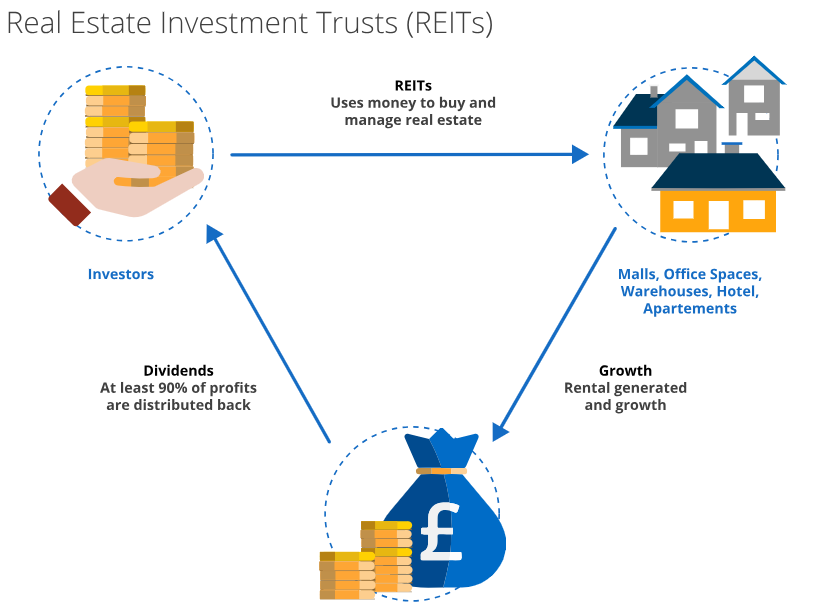Real Estate Investment Trusts (REITs): A Comprehensive Guide to Passive Real Estate Investment
Investing in real estate can be highly profitable, but for many individuals, the idea of directly purchasing, managing, or developing properties can feel daunting. Fortunately, Real Estate Investment Trusts (REITs) provide an alternative way for investors to access real estate markets without having to physically own property. This guide will take you through everything you need to know about REITs, how they work, their benefits, and potential risks. Whether you’re a seasoned investor or new to the real estate scene, understanding REITs could open up new opportunities for you to grow your wealth.
:max_bytes(150000):strip_icc()/Real-Estate-Investment-Trust-189c6cf51a03412b880b12f10ff1ee05.jpg)
What Are Real Estate Investment Trusts (REITs)?
Real Estate Investment Trusts (REITs) are companies that own, operate, or finance real estate that generates income. They pool the capital of multiple investors to purchase and manage a portfolio of real estate properties or mortgage-backed securities.
REITs offer a way to invest in real estate without the need to buy physical properties directly. Instead, investors buy shares in a REIT, which in turn allows them to receive a portion of the rental income, capital gains, or interest income generated by the properties owned by the REIT.
Key Characteristics of REITs:
- Liquidity: REITs are traded on major stock exchanges, making them much more liquid than physical real estate investments. You can buy and sell shares of a REIT like any other stock.
- Diversification: By pooling funds from many investors, REITs offer exposure to a diversified portfolio of properties, which reduces individual investment risk.
- Regular Income: REITs are required by law to distribute at least 90% of their taxable income to shareholders in the form of dividends, providing investors with a consistent income stream.
Types of Real Estate Investment Trusts
There are several types of REITs, each specializing in a different aspect of real estate investment. These include:
1. Equity REITs (Equity Real Estate Investment Trusts)
Equity REITs own and operate income-producing real estate properties, such as shopping malls, office buildings, hospitals, and apartment complexes. They generate revenue primarily through rent and lease agreements with tenants.
- Example: A well-known Equity REIT might own a portfolio of commercial office buildings, collecting rent from businesses and tenants.
2. Mortgage REITs (mREITs)
Mortgage REITs invest in real estate debt, primarily mortgages or mortgage-backed securities. These REITs make money by earning the difference between the interest income from mortgages and the cost of financing the mortgages.
- Example: A mortgage REIT might provide loans to property owners and developers or buy existing mortgages, earning interest income on those loans.
3. Hybrid REITs
As the name suggests, Hybrid REITs combine elements of both equity REITs and mortgage REITs. These REITs invest in both income-generating real estate properties and real estate debt.
- Example: A hybrid REIT might own shopping malls while also investing in mortgage-backed securities related to real estate properties.
4. Private and Public REITs
- Publicly traded REITs are listed on major stock exchanges and can be bought and sold like stocks.
- Private REITs are not listed on exchanges and are typically only available to accredited investors.
Benefits of Investing in REITs
Investing in REITs offers a variety of advantages for individual investors looking to diversify their portfolios and generate passive income.
1. Access to Real Estate with Lower Capital
Unlike direct real estate investment, which requires substantial capital for purchasing properties, REITs allow you to invest with relatively lower amounts. You can start investing in REITs with just a few hundred dollars, making them an ideal option for smaller investors.
2. Diversification
REITs provide diversification by pooling investors’ capital into a range of real estate properties, which can help reduce individual investment risk. Rather than putting all your money into one property, you can own shares in multiple properties across different sectors (residential, commercial, industrial).
3. Liquidity
Unlike physical real estate, which can take time to sell, REITs are publicly traded and can be bought or sold on the stock market. This offers a level of liquidity that is not typically available with direct real estate investments.
4. Steady Income
As mentioned earlier, REITs are required to pay out at least 90% of their taxable income as dividends. For investors seeking regular income, REITs can be an excellent source of steady cash flow.
5. Tax Advantages
REITs benefit from tax advantages since they are not taxed at the corporate level as long as they meet certain requirements, such as the 90% income distribution rule. This allows them to pass on more income to their investors.

Risks Associated with REITs
While REITs offer many advantages, there are also certain risks to consider before making an investment.
1. Market Risk
As with any stock investment, REITs are subject to market fluctuations. Economic downturns, changes in interest rates, or a shift in the demand for real estate can negatively impact the performance of REIT shares.
2. Interest Rate Risk
REITs, especially mortgage REITs, can be sensitive to changes in interest rates. When interest rates rise, the cost of borrowing increases, which can lead to lower profits for mortgage REITs. Equity REITs can also be affected as higher interest rates can reduce demand for real estate and impact property values.
3. Management Risk
The performance of a REIT depends on the expertise of its management team. Poor management decisions, such as overpaying for properties or mismanaging debt, can lead to disappointing returns.
4. Dividend Cuts
While REITs are required to distribute most of their taxable income to shareholders, this doesn’t guarantee consistent dividends. If a REIT’s properties underperform or if the market experiences a downturn, the dividend payments could be reduced or eliminated.
5. Liquidity Risk (for Private REITs)
While publicly traded REITs offer liquidity, private REITs do not have the same level of liquidity. If you invest in a private REIT, you might face challenges in selling your shares if you need to liquidate your investment quickly.
How to Invest in REITs
Investing in REITs is relatively simple, and there are several ways to get started.
1. Direct Investment in Publicly Traded REITs
The easiest way to invest in REITs is to buy shares of publicly traded REITs through a brokerage account. Many popular brokerage platforms, such as Fidelity, Charles Schwab, or Robinhood, allow you to buy and sell shares of REITs like any other stock.
- Tip: Use a diversified approach by investing in multiple REITs across various sectors to spread risk.
2. REIT Mutual Funds or ETFs
If you want to further diversify your REIT investments, you can invest in REIT mutual funds or exchange-traded funds (ETFs). These funds pool together multiple REITs, offering you exposure to a broad range of real estate investments.
- Example: The Vanguard Real Estate ETF (VNQ) is one of the most popular REIT ETFs, giving investors exposure to a variety of equity REITs in the U.S. real estate market.
3. Private REITs
If you’re an accredited investor, you may have access to private REITs, which are typically only available through specialized real estate investment platforms or investment advisors. Private REITs tend to have higher potential returns but also come with higher risks.
Frequently Asked Questions (FAQs)
Q1: What is the difference between a REIT and a real estate investment?
A1: The primary difference is that REITs pool money from investors to buy and manage real estate properties or mortgages, whereas traditional real estate investment involves purchasing individual properties for direct ownership and management.
Q2: Can REITs help me diversify my investment portfolio?
A2: Yes, REITs offer a way to diversify by adding real estate exposure to your portfolio without the complexities of directly owning property. They are also less correlated with traditional stocks and bonds.
Q3: What are the tax benefits of REITs?
A3: REITs are exempt from corporate taxes as long as they distribute at least 90% of their taxable income to shareholders. This allows them to pass more of their earnings to investors, typically in the form of dividends.
Q
4: How do I choose the right REIT to invest in?
A4: Look for REITs with strong management teams, a diversified portfolio of properties, and a consistent track record of paying dividends. Consider whether you prefer equity REITs, mortgage REITs, or a hybrid model depending on your risk tolerance and investment goals.
Conclusion
Real Estate Investment Trusts (REITs) provide an accessible and flexible way to invest in real estate without having to deal with property management. They offer benefits such as liquidity, diversification, and regular income, but they also come with risks that should be carefully considered. Whether you’re looking to build wealth through passive income or add real estate exposure to your portfolio, REITs could be the perfect investment vehicle for you.
To learn more about REITs, check out resources like Investopedia’s REIT Guide and REIT ETFs on Vanguard.

